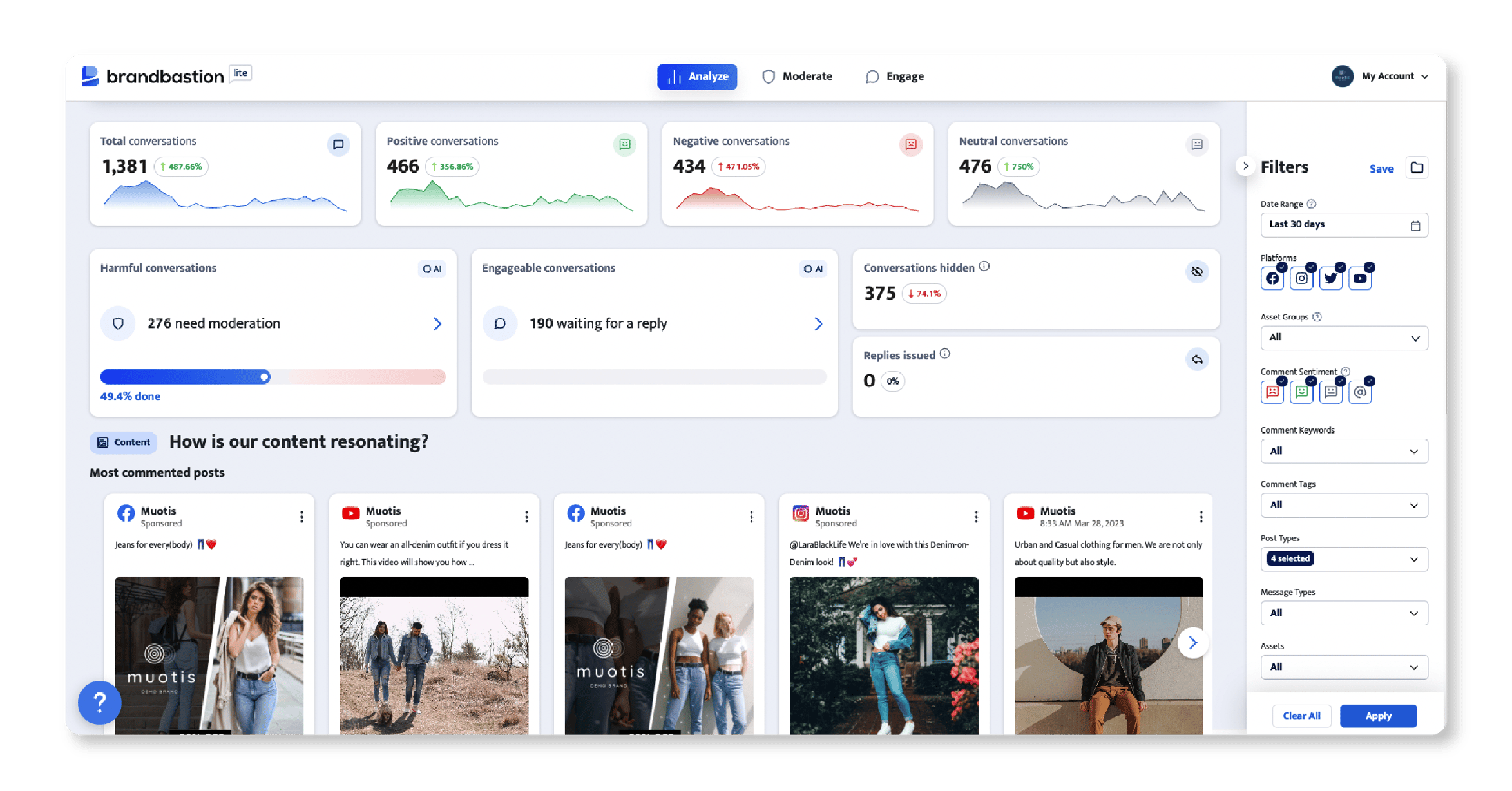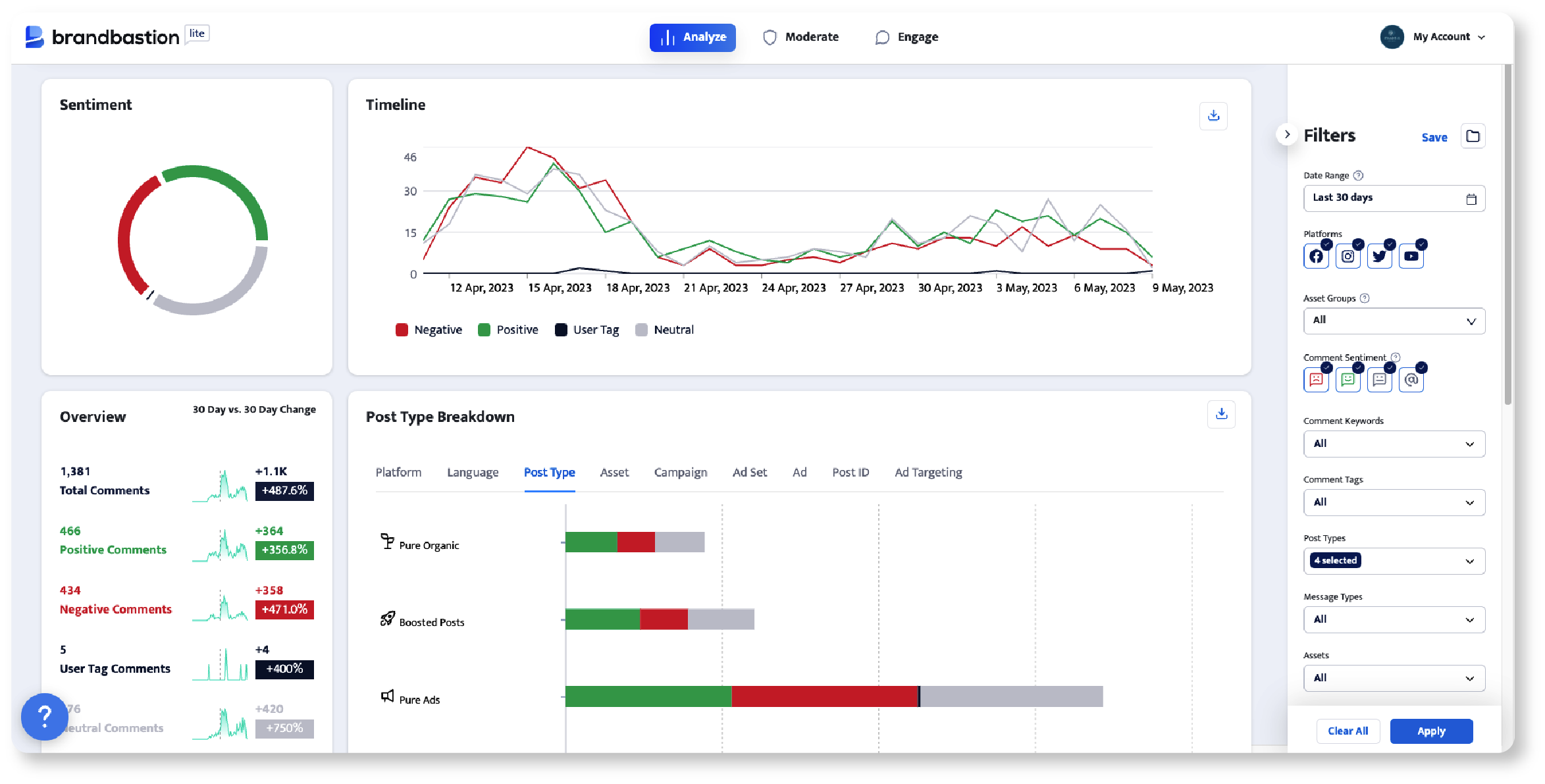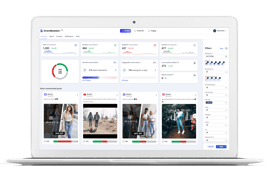
Explore Some Top Tools for Sentiment Analysis on Social Media
Sentiment analysis may seem pretty straightforward. It's all about determining if an opinion expressed through language is positive, negative, or neutral toward your brand, topic, product, or service. Right? Well, at first glance, it is that simple, but there are actually several aspects to take into account when you want to find a tool that helps you accurately understand people's perceptions. For example, you want to understand what's being said in relation to the context where it's being said. And not to forget – social media language has many different ways to express opinions in addition to the text, such as emojis, GIFs, user tags, images, or hashtags.
This article will explore what is required to get a seamless and consistent sentiment analysis across social media platforms. In addition, we have picked some of the best tools available for incorporating sentiment analysis within your social media marketing strategy.
Want to jump right to the summary? Find it here!
What is a sentiment analysis tool?
A sentiment analysis tool is a software application that uses natural language processing (NLP) and machine learning techniques to automatically analyze a text's emotional tone. Many companies and marketers use these tools to efficiently gather insights into how their target audiences on social media think and feel about a topic, product, service, or brand. The insights can then be used as a guidance for marketing or content strategies.
 Sentiment analysis tools can help you uncover actionable insights.
Sentiment analysis tools can help you uncover actionable insights.
Read more about sentiment analysis on social media here.
The benefits of using a social media sentiment analysis software
Some people argue that the best sentiment analysis is done without a tool. However, managing this process manually can be a challenge. For example, you might face difficulties achieving accurate and consistent results due to factors such as language complexity, context, personal biases, and human errors. In addition, it’s tedious to go through every single comment one by one.
Therefore, the best way of conducting sentiment analysis is to use a tool that facilitates the process and provides reliable results. The list of benefits is long, but here are a few valuable ones regardless of your company’s size or industry:
🕖 Time and cost-efficiency
Sentiment analysis tools can process a large amount of data in a short period of time, making them more efficient and cost-effective than just relying on human manual labeling. For example, some platforms allow users to create automated notifications for an unusually high volume of negative conversations. This allows marketers to stay on top of critical conversations, no matter how large the volume of conversations is.

🎯 Consistency and accuracy
Using sentiment analysis tools can be a great complement to achieving more reliable results. For example, a team of people with different backgrounds might interpret comments differently. While someone considers a comment positive, others may think it's neutral or even negative. Sentiment analysis tools use sophisticated algorithms and machine-learning techniques to classify text. Therefore, a tool can complement human annotators to ensure a consistent and accurate analysis.
⌛ Speed
Sentiment analysis tools can provide real-time analysis, which is especially useful for businesses to react fast to issues. For example, suppose a new ad receives a high negative sentiment spike. This may indicate that either the audience targeting is wrong, the creative doesn’t resonate, or perhaps something else has happened that has led to increased negativity towards the brand.
🌏 Multilingual analysis
Some sentiment analysis tools can analyze text in multiple languages, making them useful for businesses that operate globally and want to get insights across different markets or regions.
How does a social media sentiment analysis tool work?
Sentiment analysis tools use various methods and techniques to conduct sentiment analysis on social media. In fact, they vary to the extent that the results may differ significantly depending on which software you use.
A key factor when it comes to the tool's performance is how the tool determines whether the sentiment is positive, negative, or neutral. In other words, what models does it use to classify text into different categories accurately?
Within the field of conducting sentiment analysis automatically, there are three main approaches – the linguistic (rule-based) approach, the machine learning (statistical) approach, and the hybrid approach. You can also find tools that let you manually label sentiment or set up your own rules based on keywords.
The linguistic (rule-based) approach is a method that involves creating a set of rules or linguistic patterns. These rules are typically developed by linguists and experts in language processing who have a deep understanding of the structure of language and how words and phrases are used to convey sentiment.
In practice, tools with the linguistic approach to sentiment analysis, analyze the text based on predefined rules. For example, certain words and phrases might be associated with expressing a positive opinion (e.g., "love", "awesome", "excellent"), while others might be associated with expressing a negative opinion (e.g., "hate", "terrible", "awful").
The machine learning approach is a method that involves training a computer program on a labeled dataset. The dataset includes text samples that have already been manually labeled with sentiment scores.
In practice, tools with the machine learning approach train and learn algorithms to recognize patterns. Once trained, the algorithm can automatically classify new text samples by analyzing the overall sentiment of a text. Because it learns continuously, the algorithms also improve over time by simply analyzing large amounts of data.
The hybrid approach is a method that combines both the linguistic and machine-learning approach. This approach takes advantage of both methods' strengths while addressing some of their limitations. As a result, the hybrid approach usually provides more accurate analyses, compared to tools using only the rule-based or machine-learning approach.
In practice, tools with the hybrid approach to sentiment analysis involve using rule-based techniques to identify specific sentiment-bearing words and phrases in text.Then, they use machine learning algorithms to analyze the overall sentiment of the text. This allows the algorithm to leverage the efficiency and accuracy of rule-based techniques, while also taking advantage of the ability of machine learning to capture more complex patterns in language.
In short, when conducting sentiment analysis automatically, the rule-based Linguistic approach helps identify specific sentiment-bearing words and phrases. The machine learning approach trains and learns algorithms to recognize patterns to be able to classify new text samples. Finally, the hybrid approach is a way to combine these two, which usually gives the best and most accurate results since it takes both words and context into consideration. Keyword-based rules and manual labeling are basic methods that rely on additional analysis and frameworks to ensure accurate results.
At BrandBastion, we adopted the hybrid approach that enables us to achieve better results and enables us to be flexible when it comes to processing various types of data. Try out the accuracy and potential of our tool here:
Sentiment Analysis for Social Media Made Easy
START FREE TRIAL
Examine sentiment analysis software by these criteria
Before we jump into comparing some top tools available on the market, let us look into some criteria to consider when you're evaluating which tool is best for your business. By comparing different tools based on some key factors, you can find the best one that suits your needs and expectations.
| 💵 | The price and value of the tool Naturally, you want to find a tool that fits your budget and gives you value for the money you spend. One of the best ways to find out if a tool is meeting your expectations and needs, is to try it out. Most sentiment analysis tools offer free trial periods which can help you understand ROI better. |
| ☑️ | The accuracy and reliability of the tool. You want a tool that can accurately and consistently capture the tone, emotion, and attitude in social media language. Look for a tool that uses advanced and sophisticated methods, which enable complex analysis no matter context. |
| 📊 | The features and functionality of the tool Sentiment analysis is only one part of SMM-related work. Therefore, you could benefit from using a tool that also provides related features that help your business reach its goals. This could for example the ability to categorize comments, provide a visual summary, and perform intent analysis. |
Explore a selection of the top sentiment analysis tools available
At this point, we have a better understanding of sentiment analysis tools and how they work. The only thing remaining is to explore some of the top tools available on the market. So let us have a look!
1. BrandBastion platform
Let us start with our personal favorite of sentiment analysis tools – BrandBastion platform. Sentiment analysis is one of our favorite things, and we are proud to present a tool powered by advanced AI and methods.
Pros:
- Automated sentiment analysis powered by AI in 109 languages. BrandBastion offers an AI-powered and automated sentiment analysis in 109 languages, making it a great option for businesses with a global presence.
- Uses the hybrid approach. The tool uses a hybrid approach to sentiment analysis, which evaluates opinions in both context-free and business-contextualized settings, increasing the accuracy of the analysis.
- Cover paid and organic content across platforms. Our platform covers paid and organic on Facebook, Instagram, YouTube, Twitter, LinkedIn and TikTok (sentiment analysis is not available for TikTok and YouTube)
- Limited to social media platforms. BrandBastion sentiment analysis tool is limited to social media platforms only, which may not be ideal for businesses that want to analyze other channels such as email or customer support tickets.
2. Sprout Social
Sprout is mainly a tool for social media management but also offers features for social media analysis.
Pros:
- Cover a wide range of social media platforms. Sprout Social offers a wide range of platform integrations, including popular social media channels like Facebook, Instagram, and Twitter, as well as LinkedIn and Pinterest, which can be beneficial for businesses with a diverse social media presence.
- Great for labeling manually. Sprout Social’s tool offers sentiment analysis via manual tagging or automated keyword rules. Users can manually label comments based on a positive, negative, or neutral sentiment. This method can be useful for companies that prefer a more hands-on approach.
- Set up your own keyword rules. You can set up your own tailored and automated keyword rules to assign sentiment.
Cons:
- Not an AI-based sentiment analysis tool. Sprout Social's sentiment analysis method is not AI-based and relies heavily on manual methods. This is less efficient and accurate than automated sentiment analysis tools that use AI and linguistic methods.
- Keyword-based rules do not consider context. The analysis is largely based on keyword rules, which can be an unreliable approach at times, especially because it doesn’t consider the context of the words used. Moreover, keyword-based methods may not deliver additional insights as more sophisticated AI models.
- Can be expensive depending on your needs. Sprout Social's pricing can be expensive, with additional costs for each user, which can add up quickly for larger organizations or teams.
3. Hootsuite
Hootsuite has been in the social media managing and monitoring market for over a decade and is best known as a management tool. As a stand-alone, Hootsuite offers a few sentiment analysis options. However, additional apps, such as Brandwatch, enable you to explore your target audience’s opinions and emotions deeper.
Pros:
- Well-known for social media management. Hootsuite has been in the social media management and monitoring market for a long time. It is a reputable platform for managing social media accounts, which can be beneficial if you want to streamline work related to SMM (for example, scheduling and posting).
- AI sentiment analysis with additional apps. By using additional apps like Brandwatch, Hootsuite can provide more advanced sentiment analysis capabilities and cover a wide range of languages.
- Limited options for sentiment analysis without additional apps. Hootsuite's stand-alone sentiment analysis capabilities are limited and require the use of additional apps for more in-depth analysis.
- Expensive for small businesses and individuals. Hootsuite's pricing starts at a higher point than some other sentiment analysis tools, which may not be feasible for small businesses or individuals.
4. Agorapulse
Agorapulse is a social media management software with features that help you stay organized and on top of conversations across social media platforms. Agorpulse also offers some options for sentiment analysis, both manual and automated (to a certain extent). Pros:
- Good for labeling manually. The tool provides users with the ability to manually tag comments as positive, negative, or neutral, which can be useful for brands that prefer a more hands-on approach to sentiment analysis.
- Option to automate the process based on keywords. The Automated Inbox Assistant in the Advanced plan allows for rules based on keywords, which can save time and improve workflow.
Cons:
- Keyword-based rules can be inefficient and imprecise. Agorapulse's tool bases its analysis on keyword rules. This method can be time-consuming and imprecise, especially because it doesn't take into consideration the context in which words are used.
- Can be expensive depending on your needs. The pricing for the Advanced plan at $119 per user per month can be expensive for businesses with multiple users.
5. StatusBrew
Statusbrew is another all-in-one social media management tool designed to help marketers and businesses manage their social media presence across multiple platforms.
Pros:
- AI-based and automated. Statusbrew use AI and can automatically mark each conversation as positive, negative, or neutral.
- Additional insights. The platform offers some reporting, allowing you to gain valuable insights into how your audience perceives your brand.
Cons:
- Can be expensive. These features are only available in the Premium plan and above, which can be costly for small businesses or individuals.
- Only supports 12 languages. The tool only supports 12 languages. If you’re active on a global market, this could be a limitation.
Comparison of top sentiment analysis tools
|
|
BrandBastion Lite |
Agorapulse |
Hootsuite + Brandwatch |
Sprout |
Statusbrew |
|
AI-based automated sentiment analysis |
✔️ |
❌ |
✔️ |
❌ |
✔️ |
|
Languages covered (w/ translation) |
109 languages |
N/A (sentiment analysis is not automated) |
38 languages |
N/A (sentiment analysis is not automated) |
12 languages |
|
Customizable analysis options |
✔️ |
✔️ |
✔️ |
✔️ |
✔️ |
|
Sentiment reporting |
✔️ |
❌ |
✔️ |
❌ |
✔️ |
|
Notifications for spikes in volumes and sentiment |
✔️ |
✔️ |
✔️ |
✔️ |
✔️ |
|
Team collaboration |
✔️ |
✔️ |
✔️ |
✔️ |
✔️ |
1 Advanced plan, which is the only one that includes Automated Inbox Assistant
2 Business plan, which is the only one that includes Message Tagging. You may also need to pay extra to get access to Brandwatch insights
3 Advanced plan, which is the only one that includes an Inbox rule builder for automated actions. Each additional user is +$349/mo
4 Premium plan, which is the only one that includes sentiment analysis
